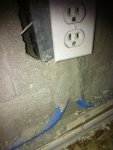Im not an electrician, so im not exactly familiar with all types of electrical conduit. I went to a site visit yesterday, and do know that ive never seen the type of conduit being used. It looks like it is some type of low voltage cable covering or something. Any ideas? Also, is that a good method of support? 


